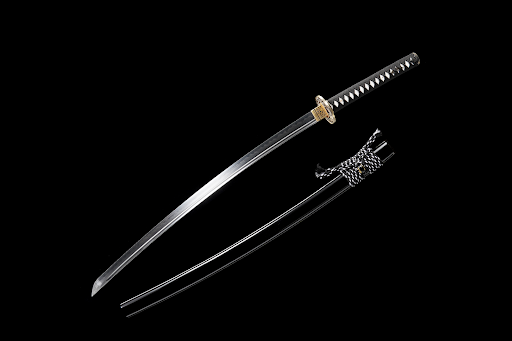For centuries, high-quality steel was used to produce Japanese swords. But here’s a surprising twist: modern Japanese swords often abandon this traditional material altogether. Instead, they embrace advanced metals like high-carbon alloys unheard of centuries ago.
So, why the shift? The evolution of swords requires every collector or enthusiast to adapt to modern needs.
This article explores the impressive metals used in today’s Japanese swords, showing how these materials combine functionality, craftsmanship, and innovation.
Historical Context of Japanese Sword-Making
Traditional Materials Used in Ancient Times
Swordsmiths used tamahagane to craft Japanese swords. This was a special type of steel fashioned from iron sand, precious for its purity and unique properties. Swordsmiths used advanced techniques like folding to purify and harden the steel. This folding process also gave the sword its distinct designs, a hallmark of traditional craftsmanship.
Shift Toward Modern Methods
The rise of industrial processes shifted Japanese sword making. Modern steel production techniques allowed for more high-quality materials. This helped to reduce the reliance on tamahagane, which was labor-intensive.
Today, traditional methods are preserved mainly for ceremonial or collector’s items. Modern swords often use alloys or high-carbon steel for their improved performance and ease of maintenance. These materials reflect how sword-making has evolved to meet contemporary demands while honoring its storied past.
Types of Metals Used in Modern Japanese Swords
Stainless Steel
Stainless steel is frequently used in modern Japanese swords. It resists rust and requires minimal maintenance, making it suited for collectors who emphasize appearance rather than functionality. However, this material is generally too hard and brittle for practical use in cutting or martial arts training. Its primary appeal lies in its shine, durability, and ease of care.
High-Carbon Steel
High-carbon steel is the preferred choice for functional katana sword uk. It contains a higher carbon percentage, enhancing hardness and edge retention. This metal closely imitates traditional tamahagane properties. However, it offers better consistency due to modern production techniques. Swords crafted from high-carbon steel are sharp, and blades are strong. They are ideal for enthusiasts who value performance over aesthetics.
Spring Steel
Spring steel is known for its toughness and flexibility. These features have made it a popular option for swords made for heavy use. It can endure repeated stress without breaking. As such, it’s often used in practice swords. Even when it lacks a traditional appearance, its functional benefits make it a top choice for durability.
Tool Steel
Tool steel is another modern alternative used in some Japanese swords. It is exceptionally hard and wear-resistant, often used in industrial applications for cutting tools. When used in sword making, tool steel offers sharpness and durability. However, it may require additional maintenance to prevent rust.
Modern Japanese swordsmiths select metals based on the blade’s intended use. This helps to balance tradition with technological advancements. Each metal offers unique value, catering to collectors, martial artists, and functional sword users.
Factors Influencing Metal Choice
Intended Use of the Sword
The purpose of the sword significantly impacts the choice of metal. Decorative swords designed for display often use stainless steel to resist rust and have a polished appearance. Functional swords for martial arts or cutting practice require durable metals like high-carbon or spring steel, capable of holding a sharp edge and withstanding impact. Collectors seeking authenticity may prefer tamahagane or alloys that mimic its qualities.
Durability and Maintenance
Another critical factor is the level of care a sword requires. Stainless steel’s rust-resistant features make it low-maintenance and ideal for collectors. Spring steels and high-carbon though durable, require regular oiling and cleaning to deter rust. For those prioritizing performance, the additional upkeep is essential for increased strength and sharper edges.
Cost and Availability
Budget and material availability also influence metal selection. Traditional tamahagane is expensive and labor-intensive, reserved for high-end or ceremonial swords. Modern alternatives like high-carbon or stainless steel are more affordable and widely accessible, allowing swordsmiths to cater to a broader market. Spring steel and tool steel balance cost-effectiveness and performance, making them popular among practitioners and functional sword users.
The choice of metal ultimately reflects a balance between aesthetics, practicality, and affordability, ensuring the sword meets the expectations of its intended audience.
Comparison of Traditional and Modern Japanese Swords
Construction Techniques
Japan’s traditional swords were created from high-quality steel. This labor-intensive process produces a flexible and strong blade. However, contemporary Japanese swords feature pre-forged metals. These materials are processed using techniques like machine forging and heat treatment. This results in uniform quality and faster production without sacrificing durability.
Aesthetic and Practical Purposes
Traditional swords focused on weapons and art. These were the cultural and spiritual principles of the samurai. They emphasized harmony, balance, and the blade’s craftsmanship. Today, swords serve varied purposes, such as display or functionality for martial arts. Modern materials provide flexibility in creating swords tailored to specific decorative or functional needs.
Performance and Reliability
Traditional swords excelled in their time, combining sharpness and flexibility ideal for combat. However, their reliance on tamahagane made them susceptible to rust and required meticulous maintenance. Modern Japanese swords, using metals like spring or high-carbon steel, offer superior durability and edge retention while being easier to maintain. While they may lack the historic allure of traditional blades, modern swords provide greater reliability for practical use and collection purposes.
Advancements in Modern Sword-Making
Use of Advanced Alloys
Modern sword-making benefits from advanced alloys, such as high-carbon, spring, and tool. These materials are engineered for consistency and offer improved strength, durability, and edge retention compared to traditional tamahagane. Alloys like stainless steel add corrosion resistance, making maintenance easier for collectors and casual users. These innovations ensure that swords meet the demands of modern functionality while maintaining aesthetic appeal.
Modern Manufacturing Techniques
Modern swordsmiths use superior techniques and tools. CNC machining and heat treatment processes offer precise detailing and shaping. This speeds up production without affecting quality. Advanced methods also improve the durability and hardness of metals for peak performance.
Environmental Considerations
Sustainability has become an essential focus in modern sword-making. Traditional processes, like crafting tamahagane, require significant natural resources and energy. Today’s manufacturers seek eco-friendly alternatives. Recycled materials and energy-efficient production methods align sword making with contemporary environmental standards.
Conclusion
Modern Japanese swords merge innovation and tradition. While traditional blades were handcrafted and steel-made, today’s swords use advanced materials to meet various needs. Techniques like CNC machining make manufacturing more efficient while retaining the artistry central to Japanese sword making.
Whether decorative or functional, the choice of metal now depends on the sword’s purpose. As advancements in technique and materials continue, modern swords honor the legacy of their predecessors.



